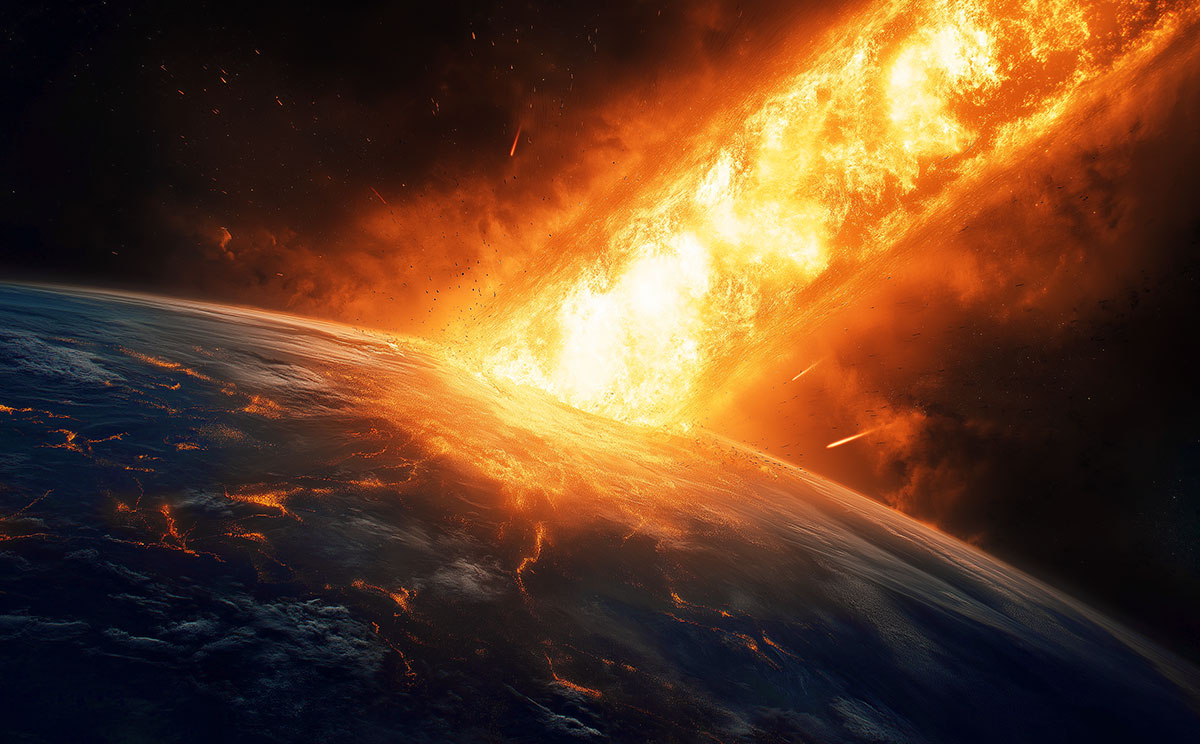 |
  
|
Defending Against the Planet KillersSkeptoid Podcast #982  by Brian Dunning We often hear about all these terrible things in space that might destroy us. Gamma ray bursts, giant asteroids, what have you; and often they are presented in a style more tilted toward sensationalism than fact. So today we're going to go through all of the common ways that popular media tells us space is trying to wipe out the Earth, and see which of them is a real concern, and which of them is not; and for those that are, we'll talk about how we might go about defending ourselves against them — if such a thing might even be possible. We'll get started with the best known of them all: A planet-killing asteroid or cometWe all know about the asteroid that killed the dinosaurs in the K-Pg extinction event, the Chicxulub impact 66 million years ago. That asteroid was 10 km wide, and wiped out three quarters of all species on Earth. If it happened again today, any surviving humans would have to rebuild in conditions that would be freezing for years, where nearly all plant life and all animals bigger than a squirrel would have been killed, intense radiation, and a challenge to find any food of any kind — even most ocean life would die. We call anything over 1 km a planet killer — that's some 8,000 times the size of the Tunguska object that wiped out part of Siberia in 1908. And there are countless such objects out there. Even discounting ones from deep space, the solar system has the Oort cloud, a whole endless supply of massive objects ready to be flung into the inner solar system. (And since we're going to mention the Oort cloud a number of times in this episode, I'll stress up front that its existence is theoretical, not proven; simply because its objects are much too far away for any imaging technology we possess to detect them. But if it's there, which would fit all of our models, it's a cloud of icy planetesimals far beyond the Kuiper belt, which is a doughnut-shaped belt of dwarf planets (including Pluto), comets, and other small objects; and which extends out to about 55 astronomical units. The Oort cloud may extend out as far as 100,000 astronomical units — that's 15 trillion kilometers — and which is the likely source of many of our long-period comets.) Impacts of planet killers average about once every half a million years. In December 2024, astronomers first discovered a near-Earth asteroid about the size of the Tunguska object, projected to have a possible impact in 2032. As we refined our observations, these probabilities went as high as 3.1%, but are now far less than 1%. This was only eight years warning. Tomorrow we might spot a planet killer with even less. Another planet killer is not an if, but a when. So what could we do about it? Here are the options:
Correction: An earlier version of this said several of the above options worked merely by changing the mass of the asteroid. Mass makes no difference to an object's orbit. You could replace Earth with a feather or with Jupiter and its orbit would not be affected. —BD The list goes on and on, as many people have come up with all kinds of cockadoodle ways that could change a large asteroid's orbit just enough. And that's all you need; just enough. Since we figure out new stuff all the time, there's a pretty good chance we might be able to handle this threat, should the day ever come. A worst case solar eventAbout the worst thing our Sun can do to us is a Carrington-level CME (Coronal Mass Ejection) event, or even a larger one. This is when the Sun's magnetic field expels a massive burst of plasma into space, and sometimes these strike the Earth, causing what we call a solar storm. In 1859, one was detected by astronomer Richard Carrington, which we now believe to have been the largest on record. Such events do not have potential to cause any direct harm to life on Earth, as we are protected by the Earth's geomagnetic field and the atmosphere. However, the particles can wreak tremendous havoc on electrical equipment. Some energetic particles can physically damage computer memory storage, and any circuit boards and wiring can be overloaded with massive surges of electrons that destroy circuits and chips. In a worst case scenario, it could take the human race back to the pre-industrial age in a matter of minutes. The scariest part of this is that such an event is the most probable of everything we talk about today. It's estimated that a Carrington-level or greater CME has up to a 12% chance of happening in the next century. Those are pretty strong odds for such a destructive event. Like the planet killer asteroid, it will happen again. Only circuitry specially hardened for environments like nuclear battlefields might escape, so hardening all circuits in a similar way would be the only defense. Otherwise, prepare to replace all your hardware, and prepare for years of no Internet, phones, or utilities. A gamma ray burst might hit usYou've probably heard how a gamma ray burst could vaporize the Earth. That's not an exaggeration; Earth would be like a sandcastle getting hit with a firehose. Nothing would be left. When a neutron star collides with another neutron star or with a black hole, two jets of plasma containing as much energy as the Sun puts out in 10 billion years are ejected in opposite directions for a few seconds. When a supermassive star collapses into a black hole, similar jets are produced for several hours. Every day, Earth gets peppered with gamma rays from such events that happened far away and long ago. Luckily, we have nothing to fear. The destructive range of these jets is about 200 light years, and there are no such objects capable of producing these within 200 light years of Earth. So, no planetary defense needed (not that it would do much good). A nearby supernovaIf a star went supernova within 65 light years of Earth, its powerful wave of neutrinos, light, UV, X-rays, gamma rays, and cosmic rays would completely destroy our ozone layer, leaving the surface uninhabitable, and killing most exposed living organisms. It's hypothesized that such supernovae may have been responsible for mass extinctions on Earth 372 Ma and 445 Ma. However, the only supernova candidate stars are all at least 150 light years from Earth. Of those, the very closest could only cause damage to the ozone minor enough that it would repair itself within a few weeks. So there's no need to move our society underground to protect ourselves from this. Correction: An earlier version of this said Ga (billions of years ago) when I meant Ma (millions of years ago). Just a brain fart by your humble servant. —BD A black hole could collide with our solar systemBlack holes can wander rogue-like through space, and we do have a number of candidate objects that might be just that. Black holes can be pretty much any mass — and since mass is mass, it affects planetary systems. For example, the Sun's gravity is the dominant force all the way out to the Oort cloud. If a black hole the mass of the Sun flew through the solar system, well, it would really mess everything up. Certainly the Earth would no longer be in the habitable zone; and that's a best-case scenario. Black holes can theoretically also be tiny. One with substantially less mass could fly right through the solar system — even right through the Earth — and do essentially no noticeable damage at all. But a supermassive one, say a million times the mass of the Sun, could easily consume the entire solar system in a blink. The nice thing is that it would be virtually impossible for a really big black hole to sneak up on us. We would observe its effects even at enormous distances. For one thing, they are powerful X-ray sources, and we have about a half dozen X-ray telescopes in orbit. We'd already know about it. Large black holes also cause optical effects in space, basically gravitational lensing. We would know about it from that, and also know if it was coming toward us, perhaps hundreds of years in advance. But as far as defense goes, there is nothing we could do at all, not even escape. If it was big enough that we could see its effects hundreds of years ahead of time, we would never be able to get far enough away from the Earth in that amount of time to escape its gravity well. Things that aren't going to happen anytime soonThere is, of course, a short list of pretty exotic things that could, or in some cases that will, eventually happen; but they are on insanely long time scales and we don't need to worry about them. Nor do future generations, nor the future generations beyond them.
That's about it — anything not mentioned here is probably so exotic that we haven't thought of it yet. Could there be such a thing? A giant exogorth could swallow the Earth. I don't have a defense for that one yet.
Cite this article:
©2025 Skeptoid Media, Inc. All Rights Reserved. |